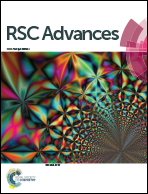Deactivation of Ti and Zr half-metallocene complexes activated with B(C6F5)3: a case study in constructing DFT-based QSARs to predict unimolecular rate constants†
Abstract
Two deactivation pathways of Ti and Zr half-metallocene complexes activated with B(C6F5)3 in toluene solvent were studied using Density Functional Theory (DFT) with dispersion corrections: (a) H transfer from the counterion to Me initiating group to release methane and (b) C6F5 transfer from the counterion to the metal. Transition state geometries and energies were computed for twenty-seven complexes, and the barrier height for the C6F5 transfer pathway was linearly correlated to the amount of steric congestion near the metal. Unimolecular rate constants for catalyst deactivation were predicted for all 27 catalysts by constructing a DFT-based quantitative structure activity relationship (QSAR). This QSAR was constructed by using the DFT-computed energy barrier (ΔV0) and vibrational frequency along the reaction coordinate (ν‡) as chemical descriptors and fitting QSAR parameters to experimental data for reference systems. The computed rate constants were in excellent agreement with the available experimental data. Specifically, the dominant deactivation pathway for each catalyst and the relative deactivation rates of different catalysts were correctly predicted. Of note, the IndTi(OC6H-2,3,5,6-Ph4)Me2/B(C6F5)3 system is predicted to have a good combination of slow deactivation and high olefin polymerization rates.


 Please wait while we load your content...
Please wait while we load your content...